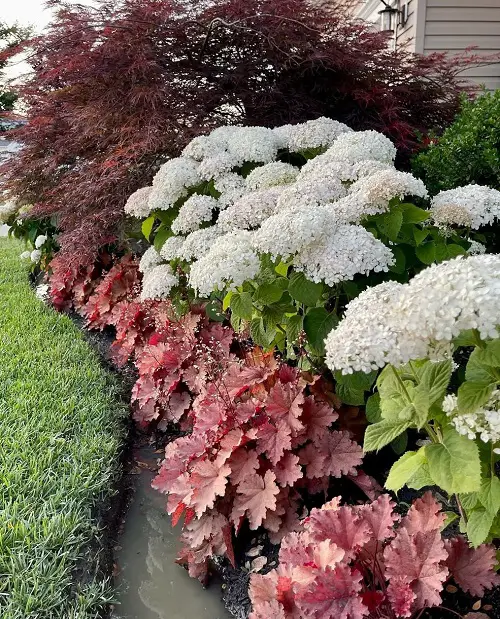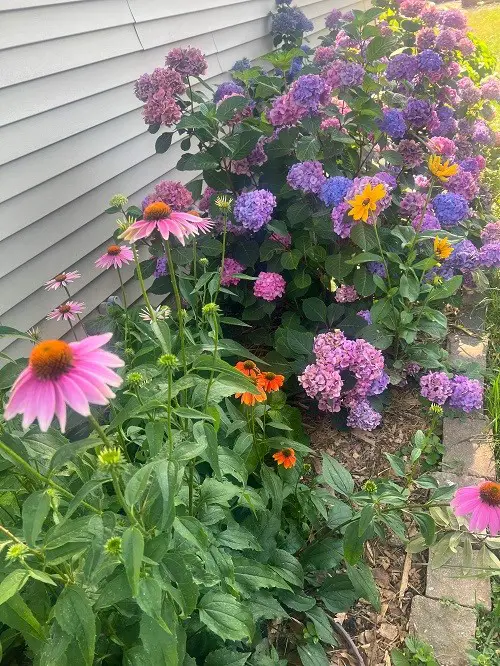Here are the Best Plants to Grow Next to Hydrangeas. With similar needs, these companions add texture, color, and depth to your garden!
Hydrangeas are floral showstoppers that shine even brighter in the company of plants with similar needs—ones that don’t compete but complete their look. Grow these companions next to them for a layered garden full of color, contrast, and seasonal depth!
How to Pick the Best Hydrangea Companions
When perusing what to plant next to hydrangeas, consider the growing factors of these compact shrubs with rounded umbrella-shaped flower clusters. They usually prefer partial shade and rich, well-draining soil to thrive, and their blooms change hue as per the soil pH.
While you could grow different types of plants next to hydrangeas, some are better suited than others. Our selection is based on similar growing needs and the aesthetic nuances they bring to your garden!
Best Plants to Grow Next to Hydrangeas
1. Azaleas
Botanical Name: Rhododendron spp.
USDA Zones: 6-8
Azaleas thrive in partial shade and acidic, rich soil, similar to hydrangeas. Its white, pink, purple, and red blooms beautifully complement the versatile hues of hydrangeas.
These low-maintenance plants are also pest-resistant, and when grown together with Hydrangeas, they promote blue blooms in them because of the acidic growing medium.
2. Coral Bells

Botanical Name: Heuchera spp.
USDA Zones: 4-9
Coral Bells also thrive in partial shade and prefer moist, slightly acidic soil. These evergreen perennials are known for their striking foliage, which comes in vibrant hues like burgundy, lime green, and bronze. Often used as ground covers, they add depth and texture.
3. Hostas

Botanical Name: Hosta spp.
USDA Zones: 3-9
Hostas are perfect, low-growing foliage companions. Their large, lush leaves in shades of green, yellow, and blue provide a lush backdrop for hydrangea blooms. Once established, they thrive in partial to full shade. However, be cautious about slugs and snails.
4. Astilbe

Botanical Name: Astilbe spp.
USDA Zones: 3-8
Astilbes are known for their shade-loving flowers that emerge as fluffy pink, purple, and white plumes. They can grow fuss-free with minimal care and occasional watering once they mature. These low-growing blooms look stellar when skirting larger hydrangeas.
5. Alliums
Botanical Name: Allium spp.
USDA Zones: 4-10
Alliums are tall perennials with globe-like flowers in purple, white, and yellow. Their strong scent deters deer and rabbits, protecting your hydrangeas from intruders. They are also drought-tolerant and require minimal maintenance, but plant them in a sunnier spot.
6. Coneflowers

Botanical Name: Echinacea spp.
USDA Zones: 3-9
Coneflowers are excellent counterpart plants for high ranges. These perennials grow back year after year and come in pink, purple, yellow, and orange. They tolerate neglect but, like alliums, prefer slightly more sun than hydrangeas. Check out these landscaping ideas.
7. Day Lilies
Botanical Name: Hemerocallis spp.
USDA Zones: 3-9
These hardy flowers can tolerate various soil conditions. Perfect for low-maintenance gardens, daylilies don’t need much attention—just regular watering and occasional feed. Their long, slender appearance contrasts the rounded, compact structure of hydrangeas.
8. Begonias
Botanical Name: Begonia spp.
USDA Zones: 6-9
Begonias are shade-loving plants with bright blooms and patterned leaves. They prefer moist, well-draining soil but are prone to root rot if overwatered. Ideal for filling gaps near hydrangeas, these compact growers flourish in porous, well-draining soil.
9. Ferns
Botanical Name: Nephrolepis spp.
USDA Zones: 3-10
Ferns are perfect for filling gaps and creating flow with their lacy, delicate fronds. These shade-loving plants thrive in moist, well-draining soil and pair beautifully with hortensia blooms. Plant a ground cover of ferns around your hydrangeas—here are the best ones!
10. Foxgloves
Botanical Name: Digitalis purpurea
USDA Zones: 4-10
With tall spikes of pink, white, and lavender bell-shaped flowers, foxgloves have part shade needs similar to those of hydrangeas, but they look entirely different! Avoid planting these delicate blooms in high-traffic areas—also because they are toxic to pets and humans!
11. Boxwood
Botanical Name: Buxux spp.
USDA Zones: 5-9
Boxwoods are evergreen landscaping plants with dense, glossy foliage that provides symmetry and formal structure to the garden. Offering year-round greenery, plant them in front of or around hydrangea bushes for a neat, tiered display of foliage and flowers.









